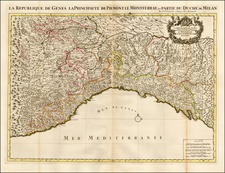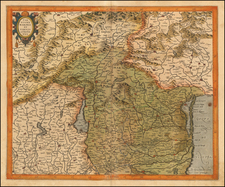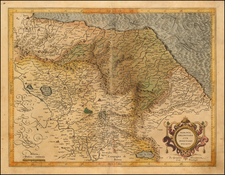Very rare original antique map of the Ligurian Sea, extending from Albenga, near the French-Italian border, through to the Archipelago Toscano in southern Tuscany, and showing the northern part of Corsica. This map appeared in Corenlis Claesz's Caertboeck Vande Midlandtsche Zee, first published in Amsterdam in 1595.
This map represents the earliest printed navigational chart of this area, drawing on previous Italian portolan charts. Highly decorated in a manner that shows the cooperation between Barentsz, Claesz, and Petrus Plancius, another important Low Countries cartographer, the map is replete with numerous sailing ships and sea monsters. Two compass roses appear with associated rhumb lines. The map also includes two cartouches, one with the title and one with a scale bar.
This map, while produced for navigational purposes, shows inland detail, with the cities of Sienna and Florence shown. On the coast, Pisa, Genoa, and Savona all appear. Numerous capes, river-mouths, and other coastal features are named, with sandbars denoted and soundings indicated.
This map appeared in the very rare French edition of the Caertboeck.
Caertboeck vande Midlandtsche Zee
Claesz's Caertboeck represents the first printed navigational atlas of the Mediterranean. Containing nine charts of regions of the Mediterranean, as well as one Portolan chart of the whole sea, the atlas was based on a number of early sources including Italian, Spanish, and Portuguese portolans as well as the travels and accumulated knowledge of Barentsz and other Dutch pilots. The atlas represented a stark contrast to earlier Dutch navigational atlases, which relied primarily on coastal views and only the most basic maps.
This atlas was first printed as its principal cartographer, Barentsz, was embarking on his ill-fated voyages that attempted to find a northern passage to China. The atlas was printed a number of times later, with the last edition in appearing 1654 after the plates passed to Jansson.
Note on the Compass Roses
The two compass roses show declinations that vary by just under six degrees. One is for a "ghemenye" compass, used in northern European waters, and is set for the magnetic variation in Northern European waters. The other, made for Italian compasses, is set for Mediterranean waters and shows the variation for that part of the world. These two compasses simplified navigation, so that sailors did not have to constantly correct for variations.
It is very unusual to see both compasses on the same map.
Rarity
This map is very rare. It is the first time we have offered it for sale. RBH lists one example as having sold in the last 20 years.










![Larii Lacus Vulgo Comensis Descriptio . . . [and] Terretorii Romani Descrip. [and] Fori Iulii Vulgo Frivli Typus](https://storage.googleapis.com/raremaps/img/small/67593.jpg)


![[Certosa di Valmanera, Asti, Piedmont] Cartusia Astensis](https://storage.googleapis.com/raremaps/img/small/89102.jpg)
![[Manuscript cadastral map of an area in the Province of Alessandria, in Piedmont, Italy]](https://storage.googleapis.com/raremaps/img/small/57264.jpg)